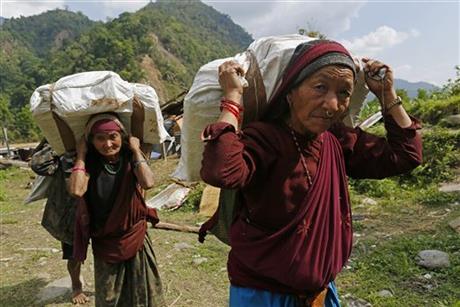BALUA, Nepal (AP) — After roughing it five nights in the rain, the 60-year-old woman finally had a plastic sheet over her head.

Sukhmaya Tamang had walked about 20 kilometers in flip-flops on mountain paths to get the emergency kit to help ward off the weather, and faced the same long journey back home.
She and hundreds of others — many elderly and all of them poor — arrived in recent days at this village to collect the emergency shelters after their remote mountain homes shaken to a shambles by Saturday’s magnitude 7.8 earthquake that radiated from the epicenter directly below.
Tamang’s cliffside hamlet in the Gorkha district can’t be reached by vehicle, and Balua is the closest place to her home that even the toughest trucks and SUVs can get to. Helicopters are scarce during the crisis, and rainy weather has further reduced their flights.
“I walked four hours to get here, and I’ve been waiting here for two days,” Tamang said Thursday while crouching amid dozens of other now-homeless and destitute women. “I have no home, no food, nothing left. I have been sleeping under the open sky.”
Five days after the massive quake, U.N. aid trucks were finally arriving — after a few false starts. Their dogged and determined drivers successfully pushed through rain-swamped and washed-out roads.
They were being joined by all manner of enthusiastic and concerned people, as local charities, foreign tourists and able-bodied village youths pitched in.
Balua village elder Shekhar Nath Neopani was stunned by the outpouring of help.
“It’s surprising to see everyone, even people who are usually divided, coming together, and all these foreign people bringing us help,” he said.
Nepal faces a crisis on multiple fronts in coming weeks and months.
Experts say it is crucial for the government and relief agencies to get food, medicine and shelter from unseasonal rains to some 1.4 million in the worst-affected regions. Collapsed latrines must be rebuilt and animal carcasses must be cleared away to avoid a sanitation nightmare.
In the longer term, Nepal’s vast farming community, making up two-thirds of the country’s 27 million people, will need help.
The U.N. Food and Agricultural Organization said the earthquake and the 73 aftershocks that have terrified the population could hamper efforts to harvest this year’s wheat crop. Many farmers have lost seed stocks for the mid-May rice sowing season, along with grains once kept dry in stone storage huts that are now reduced to rubble.
“There are so many problems. There is no place to stay. The stench of dead animals is everywhere,” Neopani said before resuming a roll call of people signed up to receive aid. “These shipments are very welcome, but we need more — much more.”
For now, the outline of an aid distribution system to Gorkha’s farthest reaches has started to take shape. Helicopters have managed some deliveries to remote regions despite erratic and stormy weather. And along the dirt road to the crumbled riverside village of Balua, a steady if somewhat motley convoy of grass-roots aid efforts has kicked into gear.
“Everyone is so happy to receive whatever they can get,” said Prabin Shrestha of the U.N.’s World Food Program, which was distributing shelters brought in by the first trucks to make it to Balua.
Others included two white-robed priests with a banner reading “Believers Church,” an Islamic anti-corruption league, and a loose-jointed, lithe bunch of Westerners who had been in Nepal paragliding when the quake hit.
Most made it only as far as the village of Rani, about 3 kilometers (2 miles) short of Balua. Individuals including young women in designer jeans, stooped old men with walking sticks, and amateur aid workers in tattoos and khakis made the 40-kilometer (25-mile) walk from Gorkha carrying backpacks and bed rolls.
“I got a tent and some food. There is some relief. Now I can sleep under cover,” said Numaya Gurung, 25. As she collected her shelter kit, her toddler eagerly grabbed at the package they would have to carry on the hours-long walk home.
The experience also was providing some inspiration. Pashmina Ghaley, a 10-year-old who had dragged her little sister to an open field after she fainted during Saturday’s quake, was enthralled by how the post-disaster despair had been transformed into resilience by the hive of activity.
“I’m very excited to see everyone here,” Pashmina said, tugging shyly at her long braid of hair behind her back. “One day, I want to be a doctor.”



Comments